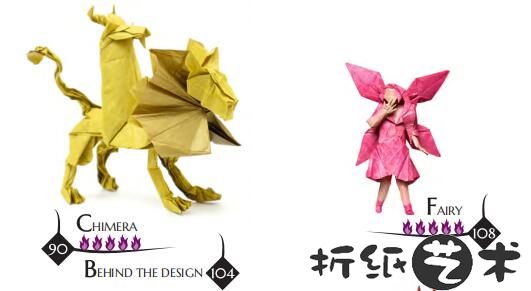幻想折纸书本简介
暂时设想你是一名折纸设计师。假设你正在尝试设计一只折纸牛。你已经折好了令人满意的前半部分,但是剩下的纸张不够用来折后腿。与其重新开始或者调整前面的部分以腾出更多纸张,你将后面的剩余纸张变成了鱼尾巴。你称这个模型为“mercow”,然后宣布它完成了。现在你完成了一个设计更容易、折叠可能比最初打算的牛要简单得多的模型。

这就是奇幻折纸的巨大自由之处。乍一看,选择最方便的身体比例,甚至创造出全新的生物,似乎如此自由,以至于感觉像作弊一样。而将一个模型标记为“奇幻”使得设计师可以摆脱任何“看起来不对”的潜在批评(值得一提的是,我急于指出,折纸社区从未如此直率,批评通常要比那更有建设性)。
然而,设计师似乎从未真正将这种批评的豁免权作为借口,以便因为可以逃避批评而采取捷径和制作简单的模型。相反,折纸设计师做的恰恰相反:虽然真实的主题往往限制了想象力并导致相对简单的图案,但是添加更多的头部、翅膀或肢体的能力使人们刻意设计了一些有史以来最复杂的折纸设计。设计奇幻折纸因此满足了一种在现实主题折纸中无法完全满足的创造欲望。
值得庆幸的是,这种神话般的复杂性并没有妨碍着热衷折纸的爱好者,这是好事,因为这个系列中包含了一些你可以通过逐步图示折叠的最困难的折纸模型,适合有必要经验的人。在这种情况下,像蝙蝠和尼斯湖水怪这样通常位于折纸难度较高的模型,仅仅是稍后模型的开胃菜,这些模型的步骤数量是前者的三倍或更多。你已经被警告了。
我还为一些模型写了一些额外的页面,名为“设计背后”,其中展示了设计过程中一些值得注意的事项。这些部分并不完整地展示了模型从头到尾的设计过程,也没有额外的帮助来实际折叠模型,但我希望这些部分对那些热衷于了解折纸设计的人会感兴趣。

我称这个系列为“第一卷”,因为我完全打算做另一本这样的书。但我不作承诺,尤其因为这本书不仅是我个人的创作,而是一个合作的作品。我对所有慷慨地付出时间和精力的人感激不尽,使得这本书成为现实。
照片与图示之间的区别:
你可能会观察到一些被摄影记录的模型与图示并不完全一致。这些差异通常限于折叠的塑形阶段,也就是说,基础(即绝大部分步骤)始终是相同的。图示仅展示了模型的一种可能解释,没有哪一种解释更加有效。
鼓励你个人的创造力比给你一个完全复制我所做的东西的确切副本更有价值。所以,自信地添加你自己的细节,并为每个模型的独特性感到自豪。
INTRODUCTION
For just a moment, put yourself in the shoes of an origami designer. Suppose you’re attempting to design an origami cow. You've folded a satisfactory front end, but you don't have enough paper left for the hind legs. Rather than starting again or adjusting the front section to free up more paper, you turn the leftover paper at the rear into a fishtail. You call the model a 'mercow', and then declare it done. Now you've finished a model which was easier to design – and probably much easier to fold – than the cow you originally intended to make.
This is the great freedom of the fantasy genre. At first glance, the ability to choose the most convenient body proportions, or even make up an entirely new creature, seems so freeing it feels like a cheat. And similarly, labelling a model as 'Fantasy' allows the designer to shrug off any potential criticism that the model "doesn't look right" (I hasten to mention that I find the origami community isn't ever this blunt and that critique is generally much more constructive than that).
Yet designers never actually seem to use this critical impunity as an excuse to take shortcuts and make easy models just because they can get away with it. On the contrary, origami designers do quite the opposite: whereas real subjects often limit the imagination and result in relatively simple figures, the ability to add more heads, wings, or limbs has led people to deliberately engineer some of the most complex origami designs of all time. Designing fantasy origami therefore satisfies a creative itch which isn't fully scratched with realistic origami subjects.
Thankfully, this mythological complexity doesn't deter the folding fanatics, which is good, because this collection contains some of the most difficult origami you can fold from step-by-step diagrams, and is intended for those with the necessary experience. In this context, models like the Bat and Loch Ness Monster, which would typically be on the upper end of origami difficulty, are merely appetisers for the later models, which have triple or more the number of steps. You have been warned.
I've also written a few extra pages entitled 'Behind the Design' for a few models which exemplify something noteworthy in the design process. None of these sections give a complete picture of designing the model from start to finish, nor any additional help on actually folding the models, but I hope these sections will be of interest to those who are keen to understand origami design.
I've called this collection 'Volume 1', because I have every intention of making another book in this series. But I make no promises, not least because this book isn't just my own creation, but a collaborative work. I owe a great debt to everyone who has so generously given their time and effort to make this book a reality.
PHOTOS VS DIAGRAMS
You may observe that some of the models photographed do not completely match the diagrams. Such discrepancies are always limited to the shaping stage of folding, meaning that the underlying base (i.e. the vast majority of steps) is always identical. The diagrams show just one possible interpretation of a model, which is no more valid than another interpretation.
Encouraging you to have personal creativity has much more value than giving you an exact replica of something I've made. So add your own details with confidence and take pride in making each model your own.
欢迎转载幻想折纸书本简介,请注明出处:跟我学做纸艺花
相关推荐

折纸专业术语大全,折纸术语有那些
92阅读(1098)

折纸符号大全,折纸中的符号都是什
106阅读(1060)

折纸技巧大全,折纸中的各种符号和
70阅读(11319)

最近很火的折纸,20个最近很火的手
64阅读(45511)

20个最火折纸大全,儿童趣味手工折
72阅读(4663)

10个适合初学者的简单折纸项目
122阅读(1462)
最新发布

十大最危险的折纸
56阅读(7574)

剪纸如何剪出美丽的图案
74阅读(224)

10步折一个战斗机甲
70阅读(3059)

如何折纸武器
67阅读(646)

小松英夫作品集折纸符号和基本技巧
59阅读(557)

幻想折纸书本简介
76阅读(417)

折纸专业术语大全,折纸术语有那些
92阅读(1098)

折纸符号大全,折纸中的符号都是什么意思?
106阅读(1060)

折纸技巧大全,折纸中的各种符号和专业术语代表什么意思
70阅读(11319)

制作好的纸张怎么裁剪成正方形,纸张怎么裁剪正方形才标准
81阅读(6357)

双层纸怎么制作,双色纸制作方法
77阅读(6269)

折纸应该用什么纸,折纸需要哪些工具
86阅读(6226)
留言评论
| 留言与评论(共有 0 条评论) |
 手工折纸大全图解_折纸花简单又漂亮_儿童折纸教程 - 折纸艺术网
手工折纸大全图解_折纸花简单又漂亮_儿童折纸教程 - 折纸艺术网




















